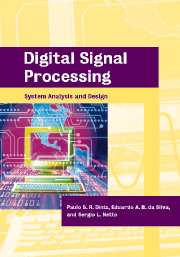
-
Select format
-
- Publisher:
- Cambridge University Press
- Publication date:
- 05 June 2012
- 18 April 2002
- ISBN:
- 9781139164580
- Dimensions:
- Weight & Pages:
- Dimensions:
- Weight & Pages:
You may already have access via personal or institutional login
Book description
Digital signal processing lies at the heart of the communications revolution and is an essential element of key technologies such as mobile phones and the Internet. This book covers all the major topics in digital signal processing (DSP) design and analysis, supported by MatLab examples and other modelling techniques. The authors explain clearly and concisely why and how to use digital signal processing systems; how to approximate a desired transfer function characteristic using polynomials and ratio of polynomials; why an appropriate mapping of a transfer function on to a suitable structure is important for practical applications; and how to analyse, represent and explore the trade-off between time and frequency representation of signals. An ideal textbook for students, it will also be a useful reference for engineers working on the development of signal processing systems.
Reviews
‘This textbook covers, clearly and concisely, the core material of a DSP course … it is suitable as the main text for an undergraduate DSP course or for a short course for practising engineers.’
Source: The Times Higher Education Supplement
'This well written textbook presents the basic mathematical methods in digital signal processing … altogether, this is a useful textbook for students in electrical engineering and a convenient reference for researchers working on digital signal processing.'
Source: Zentralblatt MATH
Contents
Metrics
Altmetric attention score
Full text views
Full text views help Loading metrics...
Loading metrics...
* Views captured on Cambridge Core between #date#. This data will be updated every 24 hours.
Usage data cannot currently be displayed.
Accessibility standard: Unknown
Why this information is here
This section outlines the accessibility features of this content - including support for screen readers, full keyboard navigation and high-contrast display options. This may not be relevant for you.
Accessibility Information
Accessibility compliance for the PDF of this book is currently unknown and may be updated in the future.


